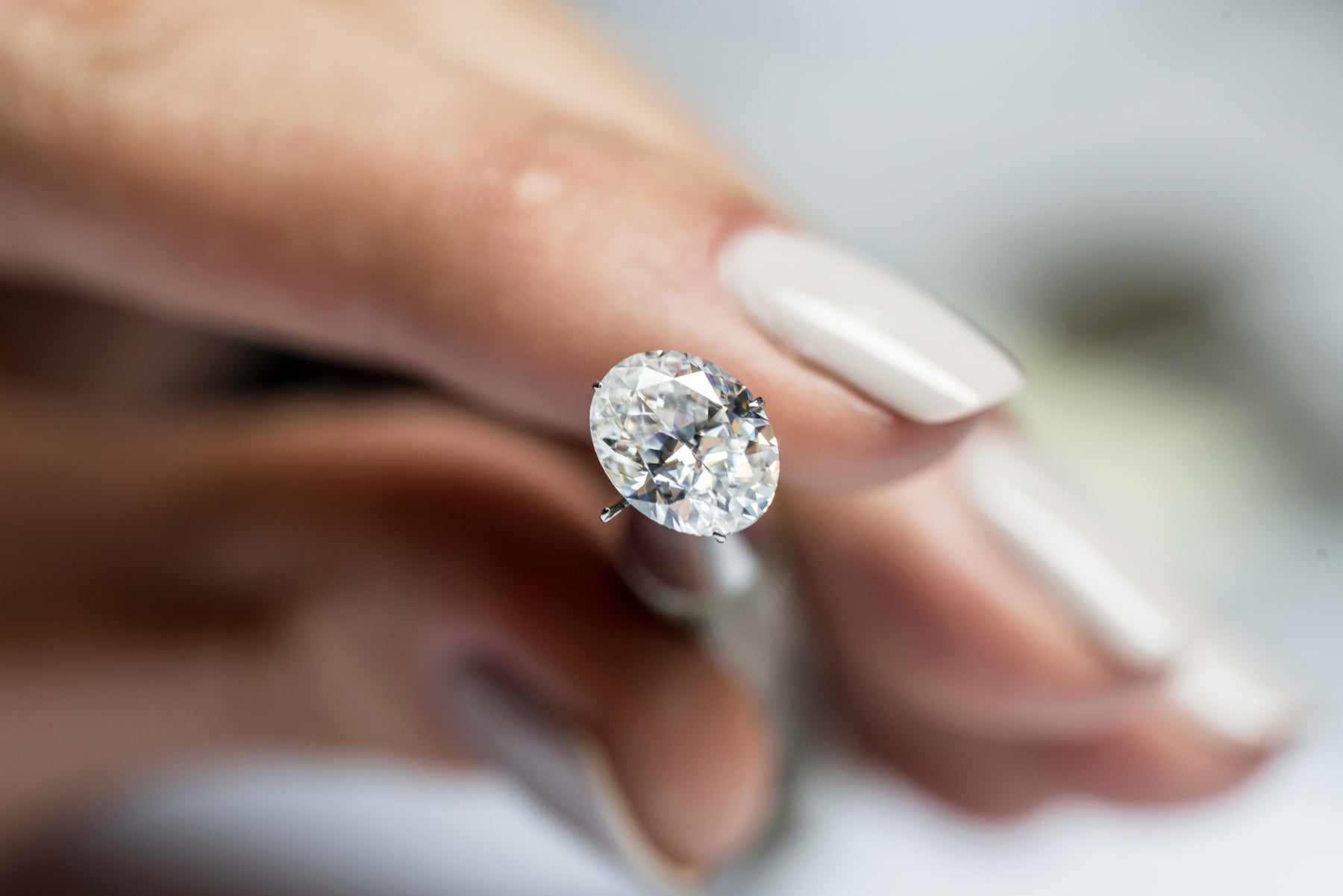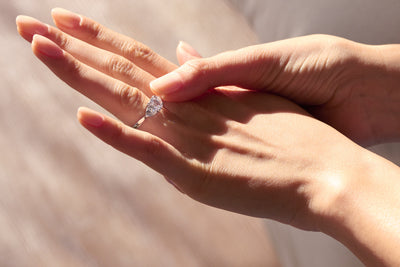
Types of Diamond Cut Guide
Ask anyone what makes a diamond special, and most will answer that it’s the classic sparkle. Put simply, the more sparkle, the better the diamond – and the more they are worth.
The way a diamond is cut is the biggest factor in how dazzling it appears. That’s why diamond cut is such a key pillar of the 4Cs grading scale. This scale categorises the quality of the stone and impacts the cost of the jewellery that carries it.
- Diamond cut is one of the 4Cs (carat, clarity, cut and colour), which decides the value of a stone
- Diamond cut refers to the facet arrangement of the stone, not the geometrical shape it is presented in
- The cut of a diamond is measured on a five-point scale, ranging from “excellent” to “poor”
What does diamond cut mean?
Diamond cut refers to the way that a diamond is cut and polished. The more symmetrical and perfectly proportioned the cut, the more the stone will sparkle.
This is a very important factor when establishing the value of both natural and lab created diamonds. That’s why it is part of the 4Cs – carat, clarity, colour and cut.
What’s the difference between a diamond’s cut and shape?
Many people get mixed up between the cut and shape of a diamond and consider it to be one and the same thing. However, they are in fact two different factors.
The cut of a diamond is the quality of cutting and polishing the facets of the stone, in order for it reflect the light in the most brilliant way.
The shape of a diamond meanwhile refers to its geometrical appearance.
How is a diamond cut?
While there are different diamond cuts, they are all cut using roughly the same method.
- Planning – Before any cutting takes place, experts evaluate the condition of the diamond in the rough. Computer software helps them map out how they will go about shaping the stone, in order to maximise quality and minimise wastage.
- Cleaving – Cleaving the diamond means splitting the stone to create separate pieces. This is usually carried out with a laser for optimal precision. However, traditionally it is a process that is carried out with a mechanical saw. This can take many hours to complete.
- Bruting – Next, the rough diamonds are refined into round pieces. This is accomplished with a process called bruting. The separate stones are fixed to opposing sides of a revolving axle so that they grind against each other. The result is that they become roughly rounded at this stage.
- Faceting – This is the process of cutting the diamond into a shape, creating facets to allow it to sparkle. This is a highly skilled process and can help make the diamond unique.
- Polishing – A special diamond powder and polishing wheel are then used to get the stone sparkling. This crucial part of the process is what creates the flat facets of the diamond. These microscopic surfaces act as mirrors, absorbing and reflecting light in the most beautiful way possible.
- Inspecting – A final inspection takes place under high magnification, in order to check that the diamond meets the required quality standards. Thorough cleaning also takes place and then the diamond is sent off to be officially assigned its value.
Are natural and lab grown diamonds cut in the same way?
Regardless of whether they have been mined or man-made in a laboratory, the craft of diamond cutting is applied in the same way.
Lab grown diamonds share the very same properties as the natural diamonds that are found underground and the process is therefore the same for turning stones into precious gemstones.
“Our lab created diamonds are cut by experienced diamond experts. It takes a highly skilled craftsperson to get the stone dazzling at its brilliant best and meet the very high standards we set on diamond quality.” Sophie Milner, Buyer for Created Brilliance."
Diamond cut chart: types of different diamond cuts
The different diamond cuts are classified with a five-point quality scale. This ranges from “Excellent” to “Poor”. The diamond cut grading chart below provides some more background on the quality required for a stone to achieve a certain score.
|
Type of diamond cut |
Description of diamond cut |
|
Excellent / Ideal |
An excellent cut diamond is perfectly proportioned. It sparkles brilliantly because its contours have been cut flawlessly, in order to maximise the reflection of light. It also boasts an exceptional level of fire, which is when white light dancing on the facets of the diamond appear as stunning rainbow colours for the naked eye. |
|
Very good |
A very good cut diamond is close in quality to excellent. It has been expertly cut to absorb and reflect most of the light. Whilst it may not quite achieve the same level of fire and symmetry as an ideal stone, it is still considered a brilliant quality diamond. |
|
Good |
The amount of light reflected by a good cut diamond is substantial. However, it does not offer the same amount of fire and sparkle as a very good or excellent stone. Despite this, a good cut diamond is still beautiful sight to behold and is a more affordable choice. |
|
Fair |
Fair cut diamonds reflect a small amount of light and have limited sparkle. Because of this, a fair cut rating will result in a lower valuation. Some diamond purchasers opt for a fair cut in order to maximise their budget on other attributes such as the size of carat. This means they can get a bigger diamond, but it will be of lower quality. |
|
Poor |
Poor cut diamonds lack sparkle because they have been cut too shallow or too deep. This greatly limits the amount of light that bounces around their facets. The price of a poor cut diamond is substantially less than those classified as fair and above. |
If you need further advice, please don’t hesitate to contact our friendly diamond experts. They can answer any queries you may have on the 4Cs quality scale.
What impacts diamond cut quality?
The quality of diamond cut is evaluated based on several proportion factors: Depth, Table, Crown, Pavilion, Girdle and Culet. The diamond cutter is trained to achieve the ideal measurements.
Depth
The depth of a diamond refers to the measurement between the diamond’s top and base. It’s expressed as a percentage, which is worked out by dividing the total height of the stone by its total width.
Creating the perfect diamond is all about getting the proportions right and the overall depth is a key part of that. If the stone is too shallow or too deep, less light will be able to pass through it and the sparkle will be less magnificent. An ideal depth is between 57.5% and 63%.
Table
A diamond’s table is the uppermost part of the stone, which can be seen when you view it from above. This part of the stone is the largest facet, so plays a crucial part in creating that dazzling sparkle.
The table is also measured as a percentage, which is calculated based on the size of the table in relation to the diamond’s width.
Crown height
Diamond crowns are the part of the stone that sits in between the table and its widest part, known as the girdle. Crown height percentage is worked out by dividing its height by the girdle diameter. Altering the crown height, or angle, will impact the balance of brilliance and fire seen in a diamond.
Pavilion depth
Pavilion depth refers to the size of the iconic “V” shape section of the diamond that sits below the girdle and reflects the facets of the stone’s table section. It is measured by taking the distance between the girdle and culet.
A well-proportioned pavilion also plays a key role in creating diamond brilliance. If it is either too shallow or too deep, then light leaks out of the back facets reducing the brilliance.
Girdle thickness
Girdle is the term for the outermost edge of the diamond. The thickness of this part is often referred to with terms like “extremely thin” or “extremely thick”.
The girdle can be polished, rough or faceted. Faceted girdles are preferred as they give the greatest transparency for the stone.
Culet
The facet or point at the base of a diamond is known as the culet. The culet size ranges from none to extremely large. If there is no culet, damage can occur to the point of the stone. However, if there is a large culet it can cause light to escape, limiting the brightness of a diamond.
How do diamonds sparkle in a perfect stone?
There are three terms most used to describe the appearance of a perfect diamond. These are brilliance, fire and scintillation.
- Brilliance refers to the brightness of a diamond. It describes the amount of white light that is reflected from the inner surfaces of a diamond back to you. A well-proportioned diamond shows a high degree of brilliance.
- Fire is the remarkable flash of rainbow colours that diamonds disperse when white light passes through their facets.
- Scintillation, also referred to as a diamond's ‘sparkle’ is the term given to the play of white and coloured flashes of light as you move a diamond.
Summary
The quality of a diamond’s cut plays a vital role in determining how sparkly and stunning it is to look at. That’s why it’s one of the 4Cs, which determine the value of a diamond. Diamond cuts range from “poor” to “excellent”. An excellent stone is cut flawlessly to maximise the reflection of light and provide a dazzling and jaw dropping appearance.

